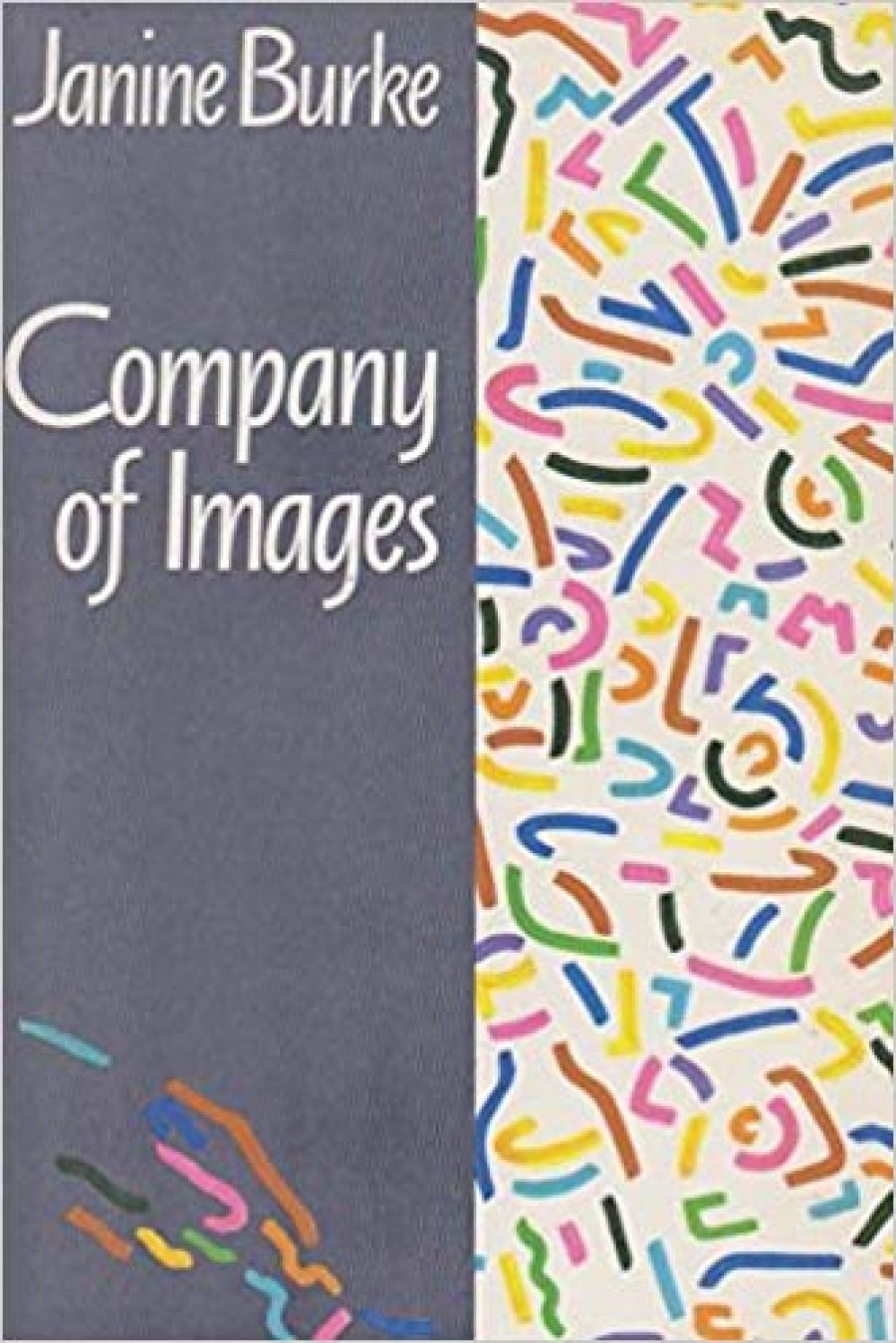
- Free Article: No
- Contents Category: Art
- Review Article: Yes
- Online Only: No
- Custom Highlight Text:
Janine Burke’s Company of Images is a funny and socially astute book about painters and their promoters in contemporary Melbourne. The humour comes from sharp observations and deft characterisations. Burke’s minor figures are like good caricatures, but her major characters are a complex blend of impulses and emotions, which can be funny or sad. She takes the opportunity to send up predictably vulnerable members of her artistic community: the painter running to seed who often feels ‘small, helpless and angry’ and seduces or denounces his students according to the state of his ego; the curator with his eyes on New York and whose ambition is ‘to have friends he was unable to frighten’; the Professor of Fine Arts who roams his Department ‘inciting suspicion and acting out his own’; and the wealthy, titled collector who brings in a curator from the State Gallery to hang a painting in her toilet.
- Book 1 Title: Company of Images
- Book 1 Biblio: Greenhouse Publications, $14.95 pb, 254 pp
The satire in Company of Images is usually affectionate as well as critical because the book is not primarily concerned with discrediting its subject. Instead, it attempts a positive exploration of what painting can mean to people. Character provides the frame for perspectives on the significance of art. Tiny, a gallery owner, could be paraphrasing John Berger on boardroom paintings when he defines art as comfort:
… art was what you went home to, collapsed on the easy chair and gazed at, or had hanging in the board room so when the deals got tough you had somewhere to look, somewhere vast, soft, other.
It is not surprising that this soft otherness is also among the clichés of femininity. In Company of Images, particular attention is given to women and art, but the main women characters are dynamic, with a significance beyond that of spectacle in the comfortingly traditional sense.
As we might expect, Burke’s women characters have problems with work and love. Alona, the academic, has a love affair with a second-year student, which places her at a disadvantage in departmental politics. The women artists’ often produce work which directly reflects the turmoil of their relationships with men. However, they are not victims, and their difficulties are resourcefully overcome.
We first meet Alona, a lecturer in Fine Arts who believes that ‘we need to consider both the artistic and the sociological’. She is researching the work of a neglected Australian woman painter, Marguerite Dance, or Maggie Dance as she was before she lived in Paris. In order to paint seriously, Marguerite had to manipulate and defy the men who had authority over her, such as her father, her first lover and her Melbourne teacher. The self-portrait which won her a scholarship to France was painted in a style calculated to appeal to the male judge, rather than satisfying Marguerite’s own artistic impulses. Interviews with Marguerite vindicate Alona’s argument about art and the importance of its social context, but Burke has a sensible cautionary approach to the recovery of that social context. Marguerite’s reaction to the catalogue of her retrospective exhibition is instructive. She is conscious of its omissions due to the emphasis of its writers and due to her own imperfect memories, and she distrusts the sense of purpose and unity which it confers on her life. Alona also suspects that ‘she’d created Marguerite in print’.
Miriam is older than Alona and has fewer opportunities for happiness. She was once a promising artist who sacrificed her inheritance and energy to promote the work of her infantile and manipulative husband. The canvases which she inspired him to paint when she was a young woman have degenerated with the relationship. Now the paint looks like ‘old blood, dried blood’. Miriam has supermarket shelves for consolation. Her obsessions find a focus as she begins, privately, to make little boxes, decorated with fragments from her domestic environment. They are a metaphor for her own compartmentalised, embellished state. They also happen to appeal to the Director of the State Gallery, whose interest in her husband’s paintings is diverted to Miriam’s assemblages. This is a satisfying, if not entirely convincing, outcome.
Carmen represents a younger, less compromising generation of women. She is judicious about art and its fashions and markets without resorting to insulting clichés – an accomplishment which her junkie boyfriend, Nick, lacks. Her own painting has ns integrity which is not influenced by pragmatic considerations. Carmen’s work escapes from the figurative and obvious as she tries to paint space in light and darkness. Carmen also conducts interviews with Marguerite for Alona. The interviews lose their formal quality, becoming conversations in which anecdotes and attitudes demonstrate similarities between the different generations of women painters. Marguerite is suspicious of feminists, but complains to Alona that ‘she was an artist extinguished due to her sex’. Carmen dismisses feminist art criticism: ‘Confuses the issue, that woman artist thing. We don’t need it.’ Yet their conversations suggest that women do have special social circumstances, and that their work is worth considering in this context.
Company of Images has a lot to recommend it. It is entertaining and informative. It is not, however, without problems, and these are perhaps inevitable because of the gap between the visual and the verbal. Although abstract painting is praised and endorsed by the book, so much art, even abstract art, is described with reference to bodies that the figurative tends to dominate. Perhaps this contributes to an implied argument that the visual is grounded, for painter and viewer, in character and community.


Comments powered by CComment